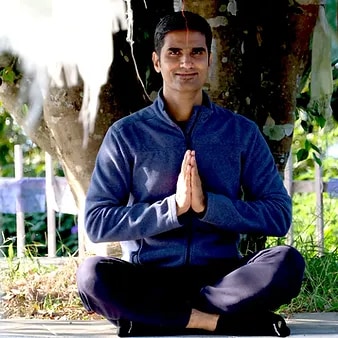Exploring Aparigraha: The Fifth Yama on the Yogic Path
by Hardik Mehta

In the journey of self-discovery and spiritual evolution outlined by the sage Patanjali in the Yoga Sutras, the Yamas serve as fundamental ethical guidelines for leading a meaningful and purposeful life. Among these principles lies Aparigraha, the fifth Yama, which invites practitioners to cultivate non-attachment and simplicity in their lives. In this blog, we will delve deep into the essence of Aparigraha, exploring its significance, practical applications, and profound impact on our well-being and spiritual growth.
Understanding Aparigraha: Embracing Non-Attachment
Aparigraha, when translated, means “non-greed” or “non-possessiveness.” At its core, it encourages individuals to let go of attachments to material possessions, desires, and outcomes. By practicing Aparigraha, one cultivates a sense of contentment, freedom, and inner peace, unburdened by the constant pursuit of external acquisitions or validations.
Breaking Free from the Chains of Possession
In a world driven by consumerism and the relentless pursuit of more, Aparigraha offers a radical alternative – the path of simplicity and minimalism. It invites individuals to reevaluate their relationship with material possessions, recognizing that true wealth lies not in accumulation but in the richness of experiences, relationships, and inner contentment.
Letting Go: The Practice of Detachment
Practicing Aparigraha involves letting go of attachments – both physical and emotional. It requires releasing the grip of possessiveness and embracing impermanence. By cultivating detachment, individuals free themselves from the cycle of craving and aversion, finding liberation in the present moment and acceptance of what is.
Embracing Simplicity: Living with Intention
Simplicity lies at the heart of Aparigraha. It encourages individuals to declutter their lives – both externally and internally – by letting go of what no longer serves them. By simplifying their surroundings, schedules, and commitments, practitioners create space for what truly matters, allowing room for growth, creativity, and authentic expression.
The Ripple Effect: Aparigraha in Action
The practice of Aparigraha extends beyond individual transformation; it has profound implications for society and the environment. By consuming mindfully and consciously, individuals reduce their ecological footprint and contribute to the well-being of the planet. Furthermore, by letting go of the need for excess, they inspire others to reevaluate their own consumption patterns, fostering a culture of sustainability and compassion.
Aparigraha in Relationships: Cultivating Freedom and Respect
In the realm of relationships, Aparigraha encourages individuals to let go of possessiveness and control, fostering freedom and mutual respect. By honouring the autonomy and agency of others, practitioners cultivate healthier, more harmonious connections, grounded in trust, understanding, and unconditional love.
Overcoming the Fear of Loss: Finding True Security Within
At the heart of Aparigraha lies the recognition that true security and fulfilment cannot be found in external possessions or circumstances. By releasing the fear of loss and embracing impermanence, individuals discover an unshakeable sense of inner security and resilience. This inner wealth transcends the fluctuations of the external world, offering a source of sustenance and strength amidst life’s uncertainties.
Integrating Aparigraha into Daily Life
Incorporating Aparigraha into daily life requires mindfulness, intentionality, and a willingness to question deeply ingrained beliefs and habits. It involves cultivating gratitude for what one has, practicing moderation in consumption, and letting go of attachments with grace and acceptance. Through conscious awareness and self-reflection, individuals gradually unravel the layers of conditioning that bind them to the illusion of possession, discovering the profound freedom that comes with non-attachment.
Harmonizing Yoga Practice with Aparigraha: Embracing Non-Attachment on the Mat and Beyond
In the journey of yoga, the ethical principles known as the Yamas serve as guiding lights, illuminating the path towards self-realization and inner harmony. Among these principles lies Aparigraha, the fifth Yama, which calls upon practitioners to cultivate non-attachment and simplicity in their lives. Through the practice of yoga, we can deepen our understanding of Aparigraha and integrate its transformative teachings into our daily lives on and off the mat.
Aparigraha in Asana Practice: Letting Go of Ego
In yoga asana practice, Aparigraha invites practitioners to release attachments to achieving perfection or comparison with others. Instead of grasping for advanced poses or seeking external validation, practitioners embrace non-attachment by honouring their bodies’ limitations and finding contentment in the present moment. By letting go of ego-driven goals, they cultivate a deeper sense of self-acceptance and inner peace on the mat.
Simplifying the Practice: Focus on Essence
Aparigraha encourages simplicity in yoga practice, emphasizing the essence of each posture rather than the complexity of its form. By stripping away unnecessary embellishments and distractions, practitioners connect more deeply with the breath, the body, and the present moment. This minimalist approach fosters mindfulness and awareness, allowing practitioners to experience the true essence of yoga beyond physical performance.
Non-Attachment to Results: Trusting the Process
In yoga practice, Aparigraha invites practitioners to relinquish attachment to the outcomes of their efforts. Instead of fixating on achieving specific results or milestones, they surrender to the journey itself, trusting in the wisdom of the practice to unfold naturally. By letting go of expectations and embracing the process with openness and curiosity, practitioners cultivate resilience and adaptability on the mat and in life.
Mindful Consumption: Nourishing the Body and Mind
Off the mat, Aparigraha extends to mindful consumption of food, media, and sensory stimuli. Practitioners cultivate non-attachment by choosing nourishing foods that support their well-being without excess or indulgence. They also exercise discernment in their media consumption, limiting exposure to negativity and cultivating mental clarity and emotional balance. By simplifying their external environment, they create space for inner reflection and spiritual growth.
Non-Attachment in Relationships: Cultivating Freedom and Respect
Aparigraha invites practitioners to release attachment to possessiveness and control in relationships, fostering freedom and mutual respect. Instead of clinging to expectations or seeking validation from others, they honour the autonomy and individuality of their loved ones. By cultivating healthy boundaries and letting go of the need for approval or validation, practitioners nurture deeper, more authentic connections grounded in trust and understanding.
Embracing Impermanence: Finding Freedom in Change
At its core, Aparigraha invites practitioners to embrace the impermanence of life and the inevitability of change. By releasing attachments to the past or anxieties about the future, they find freedom in the present moment. This acceptance of impermanence allows practitioners to navigate life’s transitions with grace and equanimity, embracing each moment as an opportunity for growth and self-discovery.
In conclusion, the practice of yoga provides a powerful vehicle for embodying the principles of Aparigraha both on and off the mat. Through asana practice, mindfulness, and self-inquiry, practitioners deepen their understanding of non-attachment and cultivate a more harmonious relationship with themselves and the world around them. By embracing simplicity, letting go of ego-driven desires, and trusting in the wisdom of the present moment, they awaken to the boundless freedom that comes with living in alignment with the transformative teachings of Aparigraha.
At Sayujya Yoga, our 200 hours Teacher Training Course (TTC) delves deep into the foundational principles of yoga as outlined by the sage Patanjali. Our comprehensive curriculum ensures a thorough exploration of Yamas and Niyamas, the ethical and moral guidelines essential for a yogic lifestyle. From Ahimsa (non-violence) to Svadhyaya (self-study), every aspect is meticulously studied and practiced, empowering our students to embody these principles both on and off the mat. With a focus on holistic development, our Yoga course in Mumbai, equips aspiring teachers with the knowledge and skills to guide others on their yoga journey with authenticity and wisdom.
About the Author

Hardik Mehta
Hardik is an E-RYT 500 & YACEP (Yoga Alliance Continuing Education Provider), Yoga Alliance, USA. He has been practicing yoga for the last 9 years. Prior to finding his true calling in Yoga, he was working with various corporates for 12 years in the Retail and eCommerce sector.
